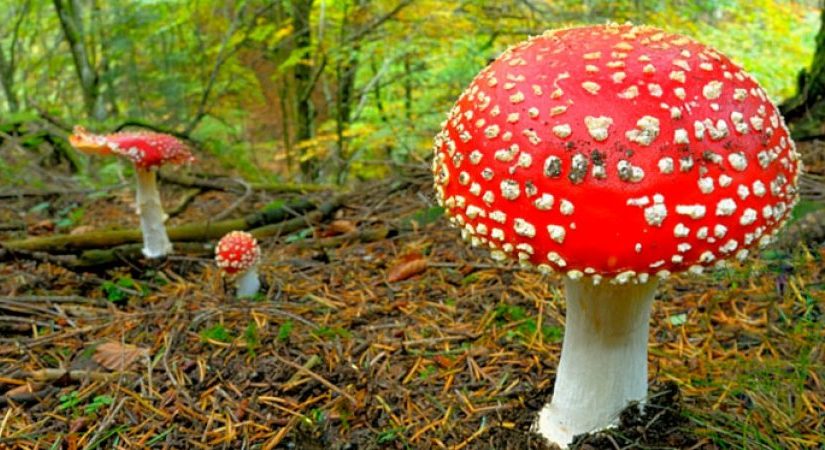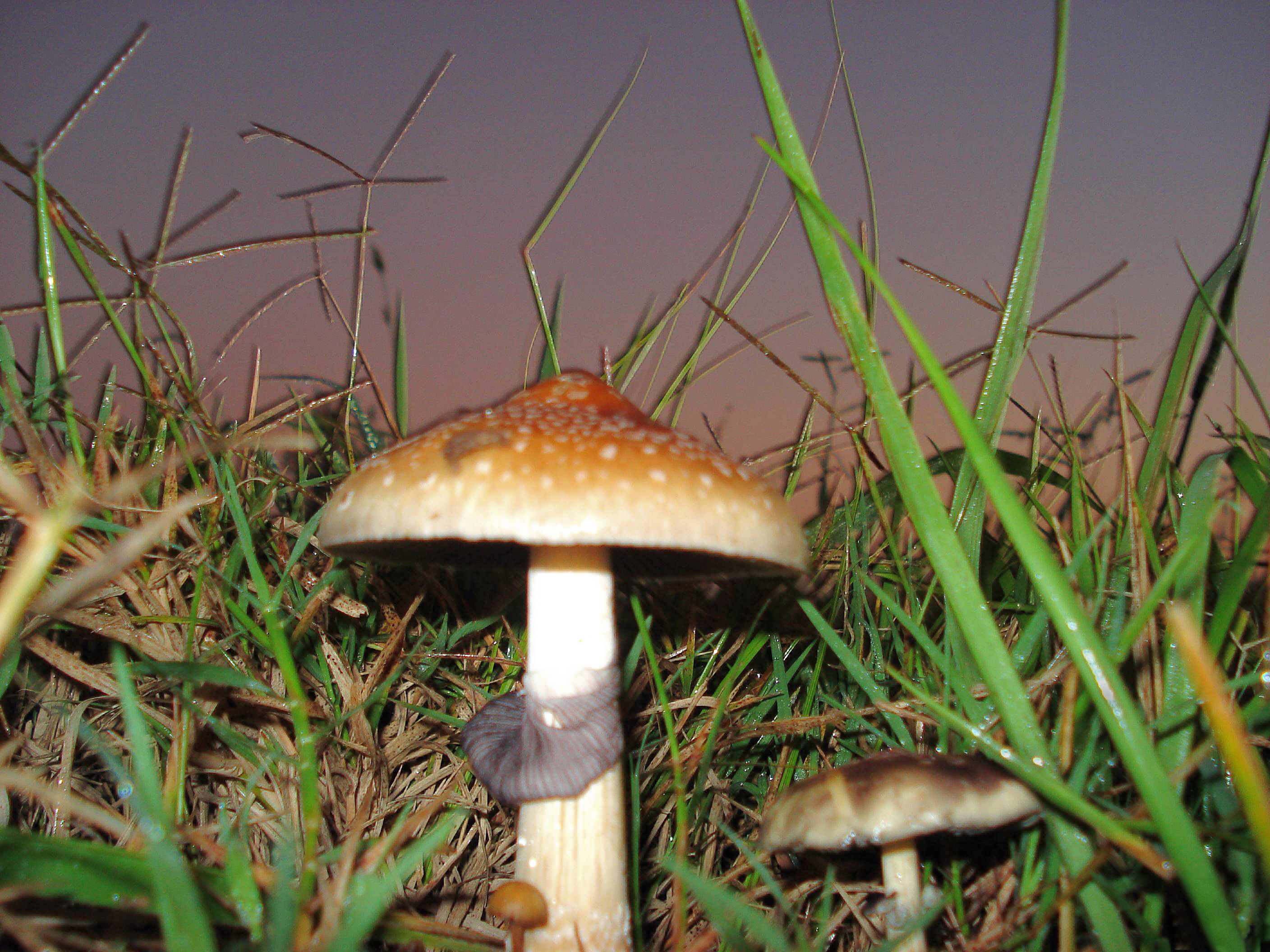by Oliver Sutton
Amanita Muscaria is an altered state of consciousness hiding in plain view. With its white-speckled red cap, the Fly Agaric, as it is also known, is the most recognisable of all mushrooms and, as such, occupies a special place in our collective imagination. From Disney and the Smurfs through to Super Mario and decorative garden ornaments, the image of Amanita Muscaria seems to have a peculiarly archetypal quality.
And yet it is a profoundly ambiguous archetype. It is profoundly attractive, inviting not merely aesthetic appreciation, but also the possibility of a deeper communion. And yet these same qualities raise an alarm that warns of toxicity and danger, making it also viscerally repellent. The mushroom itself is revered as a sacrament by the shamans of Scandinavia and Siberia and reviled as poisonous by those for whom mushrooms can be divided neatly into the edible and the inedible. It is not just the risk-averse who are divided in their evaluation of Amanita Muscaria. It also divides the psychedelic community. Gordon Wasson, the ethnomicologist who is credited with introducing Psilocybe Cubensis to the West, described it in his last book as «the supreme entheogen of all time» and was convinced that Soma, the sacrament described in the Indian Vedas was, in fact, Amanita Muscaria. The late great Terence Mckenna, an admirer of Wasson’s, and no slouch when it came to experimentation with psychoactive substances, described it as a ‘bad trip’ and as more likely to give you a bellyache than an ecstatic intoxication. The same ambivalence characterises trip reports for Amanita Muscaria on Youtube and on the forums of sites like The Shroomery. The other surprising thing is just how neglected this mushroom is, relatively speaking. In spite of it featuring so prominently in our mythologies and in our media, in spite of the fact that it is a native species across Europe, in spite of the fact that there is a European tradition of the shamanic use of this mushroom, it seems there are few takers when it comes to taking this particular little fellow. I presume that the reason for that is precisely its ambiguity, especially with regards to the question of toxicity. So, as I began to research Amanita Muscaria, with a view to taking it, it was the question of toxicity that was at the forefront of my mind.
________________
There is not nearly as much information on Amanita Muscaria as there is on psilocybe mushrooms and neither is there the level of consensus on such matters as how to prepare it, its toxicity or what to expect while under the influence. However, after trawling through many websites, reading various articles and forums and watching and listening to many different talks and accounts I started to develop a plan based on the information I was receiving. The first thing to say is that it seems the toxicity issue has been overstated. There are very few concrete examples of Amanita Muscaría poisoning. I came across one or two in scientific journals, but seen against the background of the numbers of people who must ingest this mushroom every year, it really is a very rare occurrence. More common is that people report stomach cramps, nausea and / or vomiting. It seems that vomiting is common to most experiences with Amanita Muscaria, and as such it must simply be accepted that it is a purgative in the same way the ayahuasca is. As for the stomach cramps and nausea, most people report that these symptoms occur in the early stages and that they pass relatively quickly. There is a fair amount of consensus that proper preparation of the mushroom is key to reducing these undesired side effects. To understand why requires a very brief look at its pharmacology. Among the active ingredients that Amanita Muscaria contains, the two key ones are ibotenic acid and muscamol. Muscamol is the psychoactive component, whereas ibotenic acid is largely responsible for the mushroom’s toxicity. In its fresh state, Amanita Muscaria contains a far higher proportion of ibotenic acid. However, both drying and heating the mushroom catalyses a process of decarboxylation during which the ibotenic acid is converted into muscamol. As a consequence there was an almost universal consensus that Amanita Muscaria should not be consumed fresh as you will end up with a far higher proportion of the principal toxin and not much of the psychoactive substance. Finnish shamans apparently resolved this by drinking the urine of the reindeer that feed on the mushrooms, whilst ordinary villagers would drink the urine of the shaman. Fortunately, there are simpler ways of decarboxylating the ibotenic acid. First, as previously noted, the mushrooms should be dried. Then, before consumption, a decoction can be made by putting them in water which is heated to just below simmering temperature and maintained at that temperature for around thirty minutes. Whilst this probably won’t eliminate their purgative effect it will ensure that enough of the ibotenic acid is converted to muscamol to minimize the more toxic effects. Having said all this, I have also seen a Youtube post by a seasoned user of Amanita Muscaria who insists that the ibotenic acid is an integral part of the psychoactivity of the mushroom and that, as such, the aim should not be to eliminate it altogether. My approach has been to dry it, create the decoction and take it in two stages. First 5 grams, followed by 15 grams in a few days time. It seems like a sensible precaution to take a lighter dose first given the mushroom’s reputation for being highly unpredictable with regards to dose and likely effects. As I write this the decoction that I have just made is waiting on the altar in my front room. My partner is stoking the fire and not exactly thrilled at the prospect of what I am about to do. In my next entry I will be able to give an account of the amanita muscaria experience, albeit on a low dose.
________________
I spoke too soon. The concoction that I drank had only a very mild effect. I felt slightly spaced out, it was noticeably more difficult to concentrate on simple tasks, my sense of smell was enhanced and there was some distortion of my sense of time. But all of these effects were fairly subtle and I did not get a sense of having connected with the fungus. I suspect that if the brew based on 5 dried grams was as light as that, then the brew based on the remaining 15 dried grams is not going to give rise to a powerful trip. On the positive side, I didn’t experience any nausea or abdominal discomfort, and this is encouraging for when I take the higher dose tomorrow. 5 grams was always going to be a light trip, but that seemed too light and I am wondering why it was not stronger. one possibility is the mix of mushrooms I used. I did not seek out amanita, rather it came to me in a variety of ways. One large mushroom, weighing in at 9 grams dried, was picked in Collserola, the hills next to Barcelona, and given to me by a friend one year ago. Another friend brought me a few dried Amanita Muscarias a couple of months ago from the forest around his parent’s home in Lübeck, Germany. And my partner and I found three more while looking for a lost dog in the woods near where I live in Alpens. Of these, two were rather old, and one was a perfect specimen.
There are a number of variables that could have a bearing on potency, the amount of time I stored the mushroom from Collserola, the age of two of the mushrooms from Alpens as well as the well-documented variability in potency between Amanita Muscaria mushrooms found in different locations and at different times. The other possible explanation is that something went wrong with the decoction. This is a method that has been fairly well documented and reported to be effective. I followed what seems to be as close to a ‘standard procedure’ as one can find with Amanita Muscaria- chopping the dried mushrooms as finely as I could and then heating them in water that I kept just below simmering temperature for about half an hour. This should have done the trick as both Ibotenic acid and muscamol are reported to be highly soluble in water. The resulting brew certainly had a strong meaty-mushroomy taste. I wondered whether I should have eaten the mushroom mulch that remained after the decoction was complete, but if the active compounds are as water-soluble as all the literature seems to suggest, this shouldn’t have made much difference. Another possibility is that the psychotropic effects do not show themselves until a threshold has been achieved, and that while the effects are hardly noticeable at 5 grams, all hell might break loose at 15. Whatever the reason for the lightness of the trip last Sunday, I will be taking three times as much tomorrow. If logic prevailed then I suppose I could expect an experience exactly three times more potent than that previous experience, which would still be no more than a light trip. However, in my experience psychoactive plants are not governed by anything so linear as logic. The circumstances in which you take them has a big influence on both the quality and the potency of the experience. The same can be said for the attitude that one adopts to the act of taking the mushroom. It has certainly been my experience that with psilocybe mushrooms mental preparedness can make the difference between a powerful and richly meaningful journey and an upset belly accompanied by an unsatisfying feeling of uncanniness. With this in mind, I returned to the place where we found the Amanita Muscaria to appeal to its mycelium to reveal itself to me. I got down on my hands and knees and after some low vocalisations aimed at awakening the earth beneath me, an incantation came to me which I chanted to the earth and to the forest and also to my future self who would be taking the Amanita Muscaria two days hence.
Amanita Muscaria Amanita Muscaria, I’m asking you I’m asking you, To show yourself To show yourself, To me To me.So, this is the chant that I will carry with me when I take the mushroom again later this afternoon. It would be wonderful if the higher dose and the invocations that I have made conspire to take me some place that I could never have anticipated. I’m waiting for my partner to arrive, she wanted to be present in case things should get challenging. I’ve done what I can to prepare for an encounter with this most evasive of entities. All that remains is to drink down the decoction and be open to whatever it is that might present itself.
________________
I drank down the decoction in front of the altar in our garden while my partner busied herself with planting peas. I gently beat the drum and, almost under my breath, chanted the incantation I had prepared. There was still warmth in the late afternoon sun and the garden was bathed in the orange glow that is common at that time of day. As on the previous occasion, I became aware of the effect of the Amanita Muscaria after no more than twenty minutes. As twenty minutes became one and a half hours, it became obvious that, whereas the effects were certainly stronger than on the previous occasion, there was to be no quantum leap in terms of the effects. Rather, it was proportionally stronger- logic, it would seem, had prevailed. In terms of potency, it was the equivalent to being lightly stoned or a bit drunk. But the quality of the experience was not the same. After my partner had finished with the peas and I was done with my incantations, we set about making a fire. I was always able to remain active and engaged with the task at hand, but there was a slightly dream-like quality to everything. I could gaze for long periods into the fire and enjoyed remaining still and simply observing. I tried to identify and formulate what was specific to this experience with Amanita Muscaria, but that evening I was unable to do so. It was the next day however, when we were back working in the vegetable garden that I was better able to articulate the particularity of my Amanita experience. Firstly, I was extremely sluggish while working, preferring to stop and gaze at things. It was a bright sunny day and I sat for a long while absorbed in watching the leaves fall from our kaki tree.
(The kaki tree)
I delighted at the play of light and shadow amongst the yellowing leaves and the way the wind caused them rustle and wave. It soon became apparent that whatever the Amanita had lacked in terms of potency, it made up for in terms of longevity. A whole night had passed and I was clearly still under the influence of the muscamol. What’s more I was better able to identify what was specific to the intoxication on this mushroom. It was a soporific, but not in the sense of dulling awareness or making one less alert. In fact, sensitivity to sensory input was heightened- the colours were more brilliant and the sounds more sharply defined, but everything had the quality of a lucid dream. It was not easy to concentrate on tasks and plans, but sitting and watching and listening became an end in itself and a fully absorbing activity. I spent most of the morning sitting on the bench gazing at the kaki tree, sporadically reading or dozing off, but the unmistakable trace of the Amanita was the vivid, dreamlike quality of awareness which suffused everything. I abandoned any plans I had for the rest of the day and enjoyed the sensation until by late afternoon it had taken on the more familiar quality of drowsiness and I ended up getting an early night. I can only speculate as to what a more potent trip might have been like, but this dream-like quality is quite frequently mentioned and taken to an extreme I imagine that it could result in a dissociative effect, whereby one no longer identified with what one is doing, thinking or even feeling. Should I have the opportunity to take Amanita Muscaria again, I would probably only dry it before eating it, skipping out the stage of making a decoction, even if it were to cost me an upset belly. That said, I will be in no rush to repeat the experience. A week later I took five grams of dried Cubensis mushrooms and, as has happened so often before, I enjoyed a deep, powerful, meaningful and cleansing trip.


